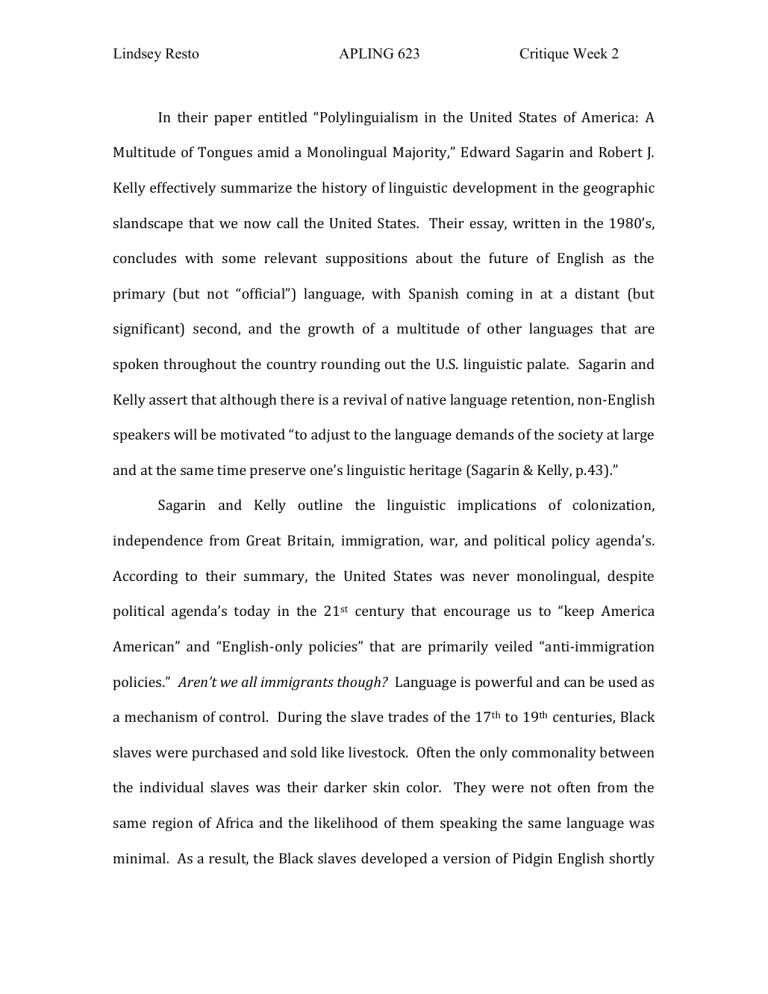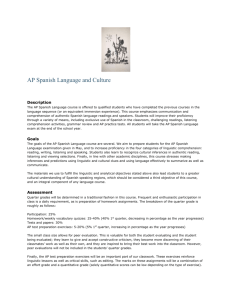APLING623RestoCritiqueWeek2 - apl623-f12-macedo

Lindsey Resto APLING 623 Critique Week 2
In their paper entitled “Polylinguialism in the United States of America: A
Multitude of Tongues amid a Monolingual Majority,” Edward Sagarin and Robert J.
Kelly effectively summarize the history of linguistic development in the geographic slandscape that we now call the United States. Their essay, written in the 1980’s, concludes with some relevant suppositions about the future of English as the primary (but not “official”) language, with Spanish coming in at a distant (but significant) second, and the growth of a multitude of other languages that are spoken throughout the country rounding out the U.S. linguistic palate. Sagarin and
Kelly assert that although there is a revival of native language retention, non-English speakers will be motivated “to adjust to the language demands of the society at large and at the same time preserve one’s linguistic heritage (Sagarin & Kelly, p.43).”
Sagarin and Kelly outline the linguistic implications of colonization, independence from Great Britain, immigration, war, and political policy agenda’s.
According to their summary, the United States was never monolingual, despite political agenda’s today in the 21 st century that encourage us to “keep America
American” and “English-only policies” that are primarily veiled “anti-immigration policies.” Aren’t we all immigrants though? Language is powerful and can be used as a mechanism of control. During the slave trades of the 17 th to 19 th centuries, Black slaves were purchased and sold like livestock. Often the only commonality between the individual slaves was their darker skin color. They were not often from the same region of Africa and the likelihood of them speaking the same language was minimal. As a result, the Black slaves developed a version of Pidgin English shortly
Lindsey Resto APLING 623 Critique Week 2 after their arrival (Sagarin & Kelly, p.26). Slave owners often prevented their slaves from learning English for fear that they would rebel.
The importance of learning or not learning English became a theme throughout the “creation” of the United States. The linguistic background of those who were colonized (the “Indians”), those who were purchased (Black slaves), and those who immigrated (Europeans, Mexicans, Russians, Chinese, among others..) would become regionally infused with English to create discernable regional accents by the 1930’s (Sagarin & Kelly, p. 43). There seems to be a constant conflict between assimilating to the ways of the “New World” (learning English) and maintaining some semblance of one’s cultural and linguistic heritage. In rural areas of agricultural industry, use of a non-English language was common for both business and social interaction. However, in the 18 th and 19 th century urban environment, linguistic “minorities” lived in ghetto’s with those who spoke their native language; English was spoken to conduct business.
The growth of Spanish in the U.S. requires its own paper to fully address.
However, Sagarin and Kelly succinctly outline the way in which the Spanish from
Spain settled in the South during the “period of colonization.,” the Spanish speaking
Mexican’s suddenly found themselves to be living in U.S. territory after the Mexican
War, the U.S. bought Florida from the Spanish, and the acquisition of Puerto Rico as a U.S. territory allowed for frequent travel to and from their “linguistic” home which likely helped the Spanish language to flourish throughout the U.S. They assert that
Spanish “is the unofficial second language of the United States” (Sagarin & Kelly, p.
41), and I am inclined to agree with them. However, most Spanish speakers would
Lindsey Resto APLING 623 Critique Week 2 further explain that there are great variations among the Spanishes in the same way that there are variations of the Englishes.
In their defense, Sagarin & Kelly were likely charged with presenting a purely historical, linguistic interpretation of the United States, so I am not inclined to fault them for not representing the social, cultural, economical, and political explanation of “Polylingualism in the United States.” However, a complete explanation would have included more depth with respect to the complex political implications that led to these groups residing in the United States and later the modified cultural context they created in their new home as it reflects on retention of their native language and assimilation into a seemingly, and perhaps falsely interpreted, English-speaking majority.
Current US policies regarding English-only education appear to be politically based in a fear of immigrants and linguistic control. Historically, we are all immigrants. English is not the de jure language of the US, although it may be the de
facto. Sagarin and Kelly, identify the historical-linguistic foundation that brought us to where we are now; a linguistically complex, politically-confused, polylingual nation in the midst of a monolingual identity crisis.
References:
Sagarin E. & R.J. Kelly (1985). “Polylingualism in the United States of America: A multitude of Tongues amid a Monolingual Majority.”








